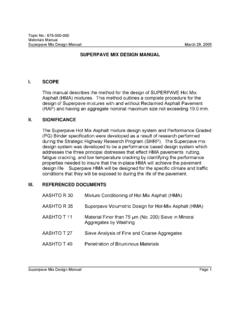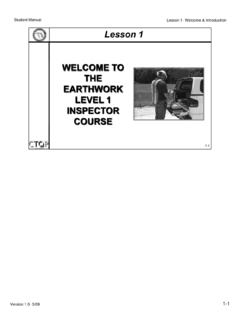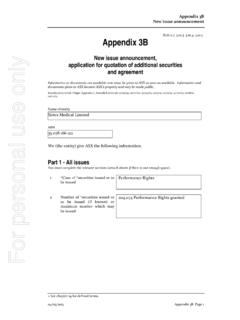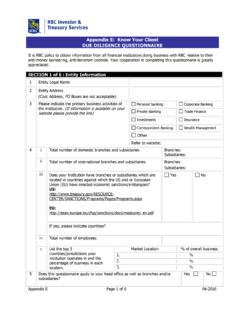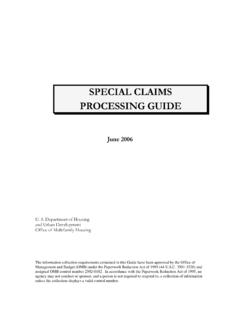Transcription of Batch Plant Calibration - ctqpflorida.com
1 Asphalt Plant Level II - July 2005 1 of 11. appendix 3b Slide 1. Construction Training Qualification Program Asphalt Plant Level II. appendix 3b Batch plants Hot Bin Calibration Practice Problems This is the technique used to Slide 2. Calibration of Hot Bins establish hot bin pulls , or the individual Batch plants bin weights, from a batching Plant . (Establishing Hot Bin Percentages and Weights for Production Requirements). July 2005 appendix 3b - 2. These are the typical procedures Slide 3. one goes through. Batch Plant Calibration 1) Start the Plant - run the cold feed, the dryer, and the screens Start the Plant - run the cold feed, the dryer, and the screens 2) After stabilization - sample the After stabilization - sample the material from material from each hot bin each hot bin 3) Washed gradations are preferred - but Washed gradation is preferred - but dry dry gradation is acceptable.
2 Gradation is acceptable 4) Then blend the aggregates to Then blend the aggregates to determine the determine the percentages from each bin percentages from each bin to meet the JMF. to meet the JMF. July 2005 appendix 3b - 3. Asphalt Plant Level II - July 2005 2 of 11. appendix 3b Slide 4 Although the blending of aggregates is shown here for hot bins, this Blending of Aggregates same process is used in blending materials for mix design as well as Batch Plant Hot Bins adjusting percentages on cold feeds based Other applications on stockpile gradations. Mix Design Cold Bins Methods Trial and Error Computer spread sheet July 2005 appendix 3b - 4. This is the formula used for the Slide 5. procedure. Blending of Aggregates P = Aa + Bb + Cc + . Where: P = % of material passing a given sieve for the blended aggregates A, B, C.
3 A, B, C, = % material passing a given sieve for each aggregate A, B, C, .. a, b, c, . = Proportions (decimal fractions). of aggregates A, B, C, to be used in blend July 2005 appendix 3b - 5. Slide 6. Blending of Aggregates P = Aa + Bb + Cc Sieve BIN 1 a BIN 2 b BIN 3 c BIN 4 d Blend JMF. 3/4 in 1/2 in 3/8 in No. 4 A Aa B Bb C Cc D Dd P. No. 8. No. 16. No. 30. No. 50. No. 100. No. 200. July 2005 appendix 3b - 6. Asphalt Plant Level II - July 2005 3 of 11. appendix 3b Slide 7 Start with the gradations of the individual aggregates and list them based Blending of Aggregates on the control sieves. Sieve BIN 1 BIN 2 BIN 3 BIN 4 Blend JMF. You can determine the blend 3/4 in 100 100 100 100 100. proportions from each bin (or material). 1/2 in 100 100 100 77 96 by: 3/8 in No. 4. 100. 100. 100. 87. 98. 19. 87. 63. 1. Experience No.
4 8 98 46. 2. Computer program No. 16 83 39. No. 30 65 31 3. By an empirical procedure No. 50. No. 100. 45. 22. 21. 11. We will use the empirical No. 200 procedure for this classroom problem. July 2005 appendix 3b - 7. Determine the amount to be Slide 8. Blending of Aggregates pulled from Bin # 1 ( ). Look for a Bin # 1 sieve where there is a lot passing for the Sieve BIN 1 BIN 2 BIN 3 BIN 4 Blend JMF No. 1 bin material and little passing for 3/4 in 100 100 100 100 100 the other bins. (No. 8 or No. 16 sieve). 1/2 in 3/8 in 100. 100. 100. 100. 100. 98. 77. 19. 96. 87. then the equation reduces to P = Aa. No. 4 100 87 63. No. 8 98 46. No. 16 83 39. No. 30 65 31. No. 50 45 21. No. 100 22 11. No. 200 a = JMF = July 2005 A appendix 3b - 8. Blending of Aggregates Determine the amount to be Slide 9. pulled from Bin # 4 ( ). This time Bin # 4.
5 Sieve BIN 1 ( ) BIN 2 BIN 3 BIN 4 ( ) Blend JMF look at the % retained = 100 (%. 3/4 in 100 45 100 100 100 100. passing), and find sieve where there is 1/2 in 100 45 100 100 77 96 some retained for Bin 4 material, and 3/8 in 100 45 100 98 19 87. No. 4 100 45 87 63. none for the other bins (1/2 sieve) then No. 8. No. 16. 98. 83. 46. 39. the equation reduces to (100 - P) = (100 . No. 30 65 31 D) d. No. 50 45 21. No. 100 22 11. No. 200 d = 100 JMF = 100 - D. July 2005 appendix 3b - 9. Asphalt Plant Level II - July 2005 4 of 11. appendix 3b Slide 10 Blending of Aggregates Distribute the remaining amount between bins 2 and 3 ( , ). Bin # 2 & # 3. Sieve BIN 1 ( ) BIN 2 BIN 3 BIN 4 ( ) Blend JMF. 3/4 in 100 45 100 100 100 15 100. 1/2 in 100 45 100 100 77 96. 3/8 in 100 45 100 98 19 87. No. 4 100 45 87 63. No. 8 98 46. No. 16 83 39.
6 No. 30 65 31. No. 50 45 21. No. 100 22 11. No. 200 July 2005 appendix 3b - 10. Blending of Aggregates Finish all the calculations. We are Slide 11. slightly out of spec on our target JMF. Bin # 2 & # 3. So, we need to try the blend again. 3/4 in 100 100 100 100 100. 1/2 in 100 100 100 77 96. 3/8 in 100 100 98 19 87. No. 4 100 87 63. No. 8 98 46. No. 16 83 39. No. 30 65 31. No. 50 45 21. No. 100 22 11. No. 200 July 2005 appendix 3b - 11. So we need to try the blend again. Slide 12. Blending of Aggregates For our second trial we will use Bin # 1 . Trial No. 2 45%; Bin # 2 19%; Bin # 3 20%; Bin Sieve BIN 1 ( ) BIN 2 ( ) BIN 3 ( ) BIN 4 ( ) Blend JMF # 4 16%. We choose these percentages 3/4 in 100 100 100 100 100 based on experience and this gets us 1/2 in 3/8 in 100. 100. 100. 100. 100. 98. 77. 19. 96. 87. closer to the JMF.
7 No. 4 100 87 63. No. 8 98 46. No. 16 83 39. No. 30 65 31. No. 50 45 21. No. 100 22 11. No. 200 July 2005 appendix 3b - 12. Asphalt Plant Level II - July 2005 5 of 11. appendix 3b Slide 13 Once the individual bin percentages are calculated, the individual weights have to be established. Determination of Bin Weights or How Much Aggregate Should be Weighed out from Each Bin July 2005 appendix 3b - 13. This slide summarizes the results Slide 14. of the previous blend calculations. The Example Problem mix will have 6% asphalt and will have the aggregate proportions shown. The To summarize Batch size will be three tons or 6000. Batch Size 6000 lbs pounds. % Asphalt 6%. Bin # 1 45 %. Bin # 2 19 %. Bin # 3 20 %. Bin # 4 16 %. July 2005 appendix 3b - 14. The first step is to determine how Slide 15. much aggregate will be in each Batch .
8 Example Problem Calculate the amount of AC in the mix 6000 * (6%) = 360 lb Total aggregate weight in the Batch 6000 - 360 = 5640 lb July 2005 appendix 3b - 15. Asphalt Plant Level II - July 2005 6 of 11. appendix 3b Slide 16 After the proportions of each aggregate have been determined it is Example Problem easy to calculate the weight required from each bin. Bin Proportion Agg wt Req. Wt. 1 45 * 5640 2538. 2 19 * 5640 1072. 3 20 * 5640 1128. 4 16 * 5640 902. July 2005 appendix 3b - 16. Slide 17. Hot Bin Calibration Practice Problem July 2005 appendix 3b - 17. Slide 18. Practice Problem Given: Batch size = 4000 lbs Asphalt content = %. Gradations shown on next sheet Required Blend the aggregates then Calculate the bin weights July 2005 appendix 3b - 18. Asphalt Plant Level II - July 2005 7 of 11. appendix 3b Slide 19.
9 Practice problem gradation Sieve Bin # 1 Bin # 2 Bin # 3 JMF. Size 3/4 inch 100 100 100 100. 1/2 inch 100 100 100 100. 3/8 inch 100 100 85 96. # 4 100 78 67. # 10 47. # 40 2 27. # 80 12. # 200 July 2005 appendix 3b - 19. Slide 20. Blending of Aggregates P = Aa + Bb + Cc Sieve Bin # 1 Bin # 2 Bin # 3 Blend JMF. 3/4 in 100 100 100 100. 1/2 in 100 100 100 100. 3/8 in 100 100 No. 4 100 No. 10 No. 40 No. 80 No. 200 July 2005 appendix 3b - 20. Slide 21. Practice Problem Calculate the AC content in the mix Total aggregate weight in the Batch July 2005 appendix 3b - 21. Asphalt Plant Level II - July 2005 8 of 11. appendix 3b Slide 22. Practice Problem To summarize Batch Size 4000 lbs % Asphalt %. Bin # 1 _____ %. Bin # 2 _____ %. Bin # 3 _____ %. July 2005 appendix 3b - 22. Slide 23. Practice Problem Bin Proportion Agg wt Req.
10 Wt. 1. 2. 3. July 2005 appendix 3b - 23. Slide 24. ANSWERS. Batch plants Hot Bin Calibration Practice Problem July 2005 appendix 3b - 24. Asphalt Plant Level II - July 2005 9 of 11. appendix 3b Slide 25. Hot Bin Calibration Practice Problem July 2005 appendix 3b - 25. Slide 26. Practice Problem Given: Batch size = 4000 lbs Asphalt content = %. Gradations shown on next sheet Required Blend the aggregates then Calculate the bin weights July 2005 appendix 3b - 26. Slide 27. Practice problem gradation Sieve Bin # 1 (.50) Bin # 2 ( ) Bin # 3 ( ) Blend JMF. 3/4 in 100 50 100 20 100 30 100 100. 1/2 in 100 50 100 20 100 30 100 100. 3/8 in 100 50 100 20 No. 4 100 50 No. 10 No. 40 No. 80 No. 200 July 2005 appendix 3b - 27. Asphalt Plant Level II - July 2005 10 of 11. appendix 3b Slide 28. Example Problem Calculate the AC content in the mix 4000 * ( ) = 220 lb Total aggregate weight in the Batch 4000 - 220 = 3780 lb July 2005 appendix 3b - 28.


